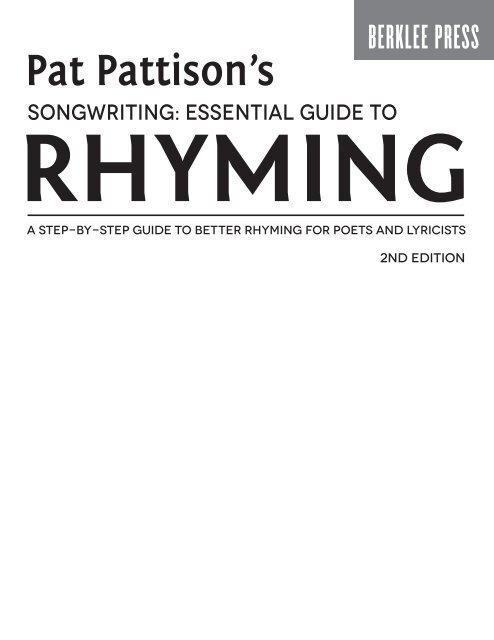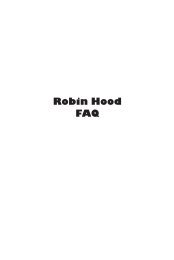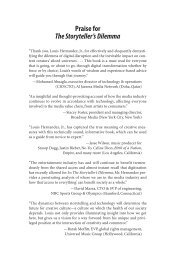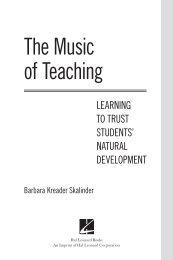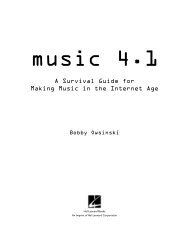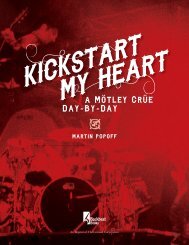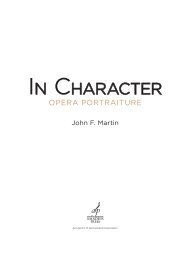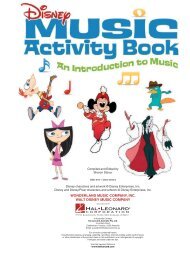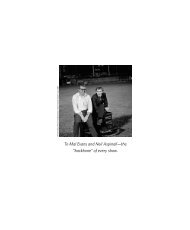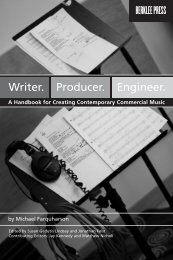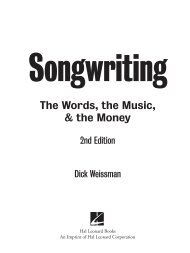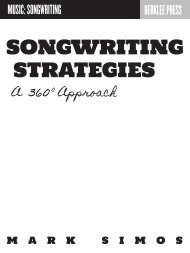Pat Pattison's Songwriting: Essential Guide to Rhyming - 2nd Edition: A Step-by-Step Guide to Better Rhyming for Poets and Lyricists
- TAGS
- song
- music
- rhyming
- songwriting
You also want an ePaper? Increase the reach of your titles
YUMPU automatically turns print PDFs into web optimized ePapers that Google loves.
<strong>Pat</strong> <strong>Pat</strong>tison’s<br />
BERKLEE PRESS<br />
SONGWRITING: ESSENTIAL GUIDE TO<br />
RHYMING<br />
A STEP-BY-STEP GUIDE TO BETTER RHYMING FOR POETS AND LYRICISTS<br />
<strong>2nd</strong> edition
To Jason, Holly, Suzanne, Maia, Olivia, Jim, Gillian, S<strong>and</strong>y, <strong>and</strong> Chris <strong>for</strong> your love <strong>and</strong> support.<br />
To my brothers <strong>and</strong> sisters: thanks <strong>for</strong> the pins you keep<br />
at ready <strong>to</strong> stick in<strong>to</strong> my balloon when it gets <strong>to</strong>o full of hot air.<br />
And <strong>to</strong> my darling wife, Clare McLeod. You make everything possible.<br />
Berklee Press<br />
Edi<strong>to</strong>r in Chief: Jonathan Feist<br />
Vice President of Online Learning <strong>and</strong> Continuing Education: Debbie Cavalier<br />
Assistant Vice President of Operations <strong>for</strong> Berklee Media: Robert F. Green<br />
Assistant Vice President of Marketing <strong>and</strong> Recruitment <strong>for</strong> Berklee Media: Mike King<br />
Dean of Continuing Education: Carin Nuernberg<br />
Edi<strong>to</strong>rial Assistants: Matthew Dunkle, Reilly Garrett, Zoë Lustri, Sarah Walk<br />
Cover Design: Ranya Karifilly, Small Mammoth Design<br />
Drawing of Rhyme Types Man: Rachel Kice<br />
HASTEN DOWN THE WIND<br />
Words <strong>and</strong> Music <strong>by</strong> WARREN ZEVON<br />
© 1973 (Renewed) WARNER-TAMERLANE PUBLISHING CORP. <strong>and</strong> DARKROOM MUSIC<br />
All Rights Administered <strong>by</strong> WARNER-TAMERLANE PUBLISHING CORP.<br />
All Rights Reserved<br />
FEELS LIKE HOME<br />
Words <strong>and</strong> Music <strong>by</strong> RANDY NEWMAN<br />
© 1996 RANDY NEWMAN MUSIC (ASCAP)<br />
All Rights Reserved<br />
ISBN 978-0-87639-150-1<br />
1140 Boyls<strong>to</strong>n Street<br />
Bos<strong>to</strong>n, MA 02215-3693 USA<br />
(617) 747-2146<br />
Visit Berklee Press Online at<br />
www.berkleepress.com<br />
Visit Hal Leonard Online at<br />
www.halleonard.com<br />
Berklee Press, a publishing activity of Berklee College of Music, is a not-<strong>for</strong>-profit educational publisher.<br />
Available proceeds from the sales of our products are contributed <strong>to</strong> the scholarship funds of the college.<br />
Copyright © 1991, 2014 Berklee Press<br />
All Rights Reserved<br />
No part of this publication may be reproduced in any <strong>for</strong>m or <strong>by</strong><br />
any means without the prior written permission of the Publisher.
CONTENTS<br />
ACKNOWLEDGMENTS ............................................. v<br />
FOREWORD BY GARY BURR ..................................... vii<br />
PREFACE . . . . . . ................................................. viii<br />
INTRODUCTION. DO I HAVE TO RHYME?.......................... ix<br />
Something Unnatural.......................................ix<br />
Something Cliché...........................................xi<br />
CHAPTER 1. RHYME IS YOUR FRIEND.............................. 1<br />
Shaking H<strong>and</strong>s ............................................. 1<br />
Masculine Rhymes/Feminine Rhymes ....................... 3<br />
Finding Rhymes ........................................... 5<br />
Using Your <strong>Rhyming</strong> Dictionary ............................. 7<br />
CHAPTER 2. EXCHANGING BUSINESS CARDS ...................... 9<br />
Rhyme Spotlights Ideas ..................................... 9<br />
Rhyme Connects Ideas ..................................... 12<br />
Going Deeper ........................................... 15<br />
CHAPTER 3. GETTING REFERENCES ..............................19<br />
Worksheets................................................ 19<br />
CHAPTER 4. FAMILY FRIENDS ....................................25<br />
Exp<strong>and</strong>ing Rhyme Possibilities ............................. 25<br />
Perfect Rhyme Substitutes.................................. 29<br />
Family Rhyme .......................................... 29<br />
Phonetic Relationships .................................... 30<br />
Plosives ................................................. 30<br />
Fricatives ............................................... 35<br />
Nasals .................................................. 39<br />
Feminine Family Rhymes .................................. 41<br />
Syllables Ending in More than One Consonant .............. 43<br />
L <strong>and</strong> R . . . . . . . . . . . . . . . . . . . . . . . . . . . . . . . . . . . . . . . . . . . . . . . . . . . .45
CHAPTER 5. FRIENDLY RELATIVES ...............................49<br />
Additive/Subtractive Rhyme ............................... 49<br />
Words Ending in Vowels ................................. 49<br />
Syllables with Consonant Endings .......................... 53<br />
Family Additives .......................................... 55<br />
Subtractive Rhyme ........................................ 55<br />
CHAPTER 6. KISSIN’ COUSINS ....................................59<br />
Assonance Rhyme ......................................... 60<br />
Feminine Assonance Rhyme ............................... 61<br />
Consonance Rhyme: From Birth <strong>to</strong> Death ................... 63<br />
Partial Rhyme: From Cradle <strong>to</strong> Grave........................ 65<br />
CHAPTER 7. THE FRUITS OF FRIENDSHIP.........................69<br />
CHAPTER 8. SONIC BONDING. ....................................77<br />
Internal Rhyme. ........................................... 77<br />
Assonance ................................................ 79<br />
Simple Assonance ....................................... 80<br />
Hidden Assonance ....................................... 82<br />
Family Assonance ....................................... 88<br />
Alliteration ................................................ 91<br />
Horizontal <strong>and</strong> Vertical Consonant Families................. 93<br />
The Activity of the Air Column.............................. 93<br />
Concealed Alliteration ..................................... 98<br />
Juncture ................................................. 101<br />
Voice Leading <strong>and</strong> Prosody ................................ 104<br />
CHAPTER 9. CRAFT AND RHYME TYPES .........................107<br />
AFTERWORD. . . . ................................................119<br />
INDEX . . . . . . . . . ................................................ 120<br />
ABOUT THE AUTHOR. .......................................... 123
ix<br />
INTRODUCTION<br />
Do I Have To Rhyme?<br />
Songs are made <strong>for</strong> ears, not eyes. Because people listen <strong>to</strong> songs, you<br />
must learn <strong>to</strong> write <strong>for</strong> eyeless ears. Rhyme creates a sonic roadmap:<br />
it tells those eyeless ears where <strong>to</strong> go <strong>and</strong> when <strong>to</strong> s<strong>to</strong>p. It shows them<br />
the way. So many times, rhyme seems like your enemy. Because it’s so<br />
hard <strong>to</strong> use rhyme <strong>and</strong> still sound natural, most songwriters go through<br />
a “trying not <strong>to</strong> rhyme” phase. Too often, rhyme seems <strong>to</strong> pull you in a<br />
wrong direction, either (1) <strong>to</strong>wards something that sounds unnatural, or<br />
(2) <strong>to</strong>wards something cliché. Both drain the blood from your lyric.<br />
SOMETHING UNNATURAL<br />
How many appeals have gone “<strong>to</strong> the stars above?” How many emotions have<br />
flown in on “the wings of a dove?” Those countless stars <strong>and</strong> doves have every right<br />
<strong>to</strong> feel like teenagers who get attention only because they hang out with someone<br />
more desirable. In this case, “love.” They aren’t really wanted <strong>for</strong> themselves.<br />
The need <strong>to</strong> rhyme has certainly held the shotgun at many an improbable<br />
wedding. You may have been <strong>to</strong> a few yourself….<br />
Sometimes, the search <strong>for</strong> rhyme is even more destructive. Everyone has<br />
been in this situation: trying <strong>to</strong> find a way <strong>to</strong> connect words like<br />
liege/besiege<br />
(No problem with cliché here.) Unless you were writing a comedy version of<br />
King Arthur or Robin Hood, you might never face this particular problem, but<br />
you have faced it in other ways many times. And you will face it again.
x Introduction<br />
“Besiege” is a transitive verb; you must use a direct object like “the castle”<br />
<strong>to</strong> complete its sense. Putting a transitive verb at the end of a phrase inverts the<br />
natural sentence order:<br />
He swore an oath un<strong>to</strong> his liege<br />
Tomorrow, the castle he would besiege.<br />
You can pull your poetic license out of your back pocket all you want <strong>to</strong>, but<br />
it won’t make the phrase sound any more natural. You’ll still sound like Yoda.<br />
Of course, the natural syntax is<br />
He swore an oath un<strong>to</strong> his liege<br />
Tomorrow he would besiege the castle.<br />
You might try<br />
He swore <strong>to</strong> his liege as a loyal vassal<br />
Tomorrow he would besiege the castle.<br />
The first phrase is ambiguous. Is the liege the vassal? Even though “liege/<br />
besiege” are in the same internal spot, the meaning is now a bit obscured. This<br />
is better:<br />
To his liege, he swore as a loyal vassal<br />
Tomorrow, he would besiege the castle.<br />
This is a lot of twisting in the wind <strong>for</strong> a rhyme. And you still didn’t get<br />
liege/besiege<br />
…in the rhyming position. The problem is familiar <strong>to</strong> anyone who has worked<br />
with rhymes, especially where only a few rhymes are available. For “liege,”<br />
there is only<br />
besiege/siege<br />
Fortunately, “siege” is a noun.<br />
He swore an oath un<strong>to</strong> his liege<br />
To lay the castle under siege.<br />
A lucky escape.
Introduction<br />
xi<br />
SOMETHING CLICHÉ<br />
Having only a few rhymes available can cause even worse problems. Too often,<br />
the available rhymes have been used so much that they’ve become cliché. Have<br />
you ever tried <strong>to</strong> rhyme “love?” Or “desire?” Try <strong>for</strong> a minute. Make a list <strong>for</strong><br />
each one.<br />
Love<br />
Desire<br />
I thought of “inspire.” Alas, it turns in<strong>to</strong> the transitive verb problem. It<br />
threatens <strong>to</strong> sound unnatural:<br />
You fill me with a strong desire<br />
Heat like this you can inspire<br />
Using cliché rhymes is pretty risky business. Most likely, your listener will start<br />
napping as soon as it is clear that you intend <strong>to</strong> use one of these old war horses.<br />
Un<strong>for</strong>tunately, English is full of them. Faced with these two problems:<br />
1. using something that sounds unnatural, or<br />
2. using cliché rhymes<br />
…you might be tempted <strong>to</strong> chuck rhyme al<strong>to</strong>gether.<br />
The problem is, refusing <strong>to</strong> rhyme hurts a lyric more than it helps it. This<br />
isn’t true in poetry, but remember, poetry is <strong>for</strong> the eye <strong>to</strong>o. Rhymes in a lyric<br />
are the ear’s road signs, just like lines in poetry are the eye’s road signs. In the<br />
time of the troubadour, when poetry was oral, it always rhymed. It was made<br />
<strong>for</strong> the ear, not the eye.
19<br />
CHAPTER 3<br />
Getting References<br />
If you’re lonely <strong>and</strong> you want <strong>to</strong> make friends, you should go places where<br />
you’re likely <strong>to</strong> find people you have things in common with. Maybe go <strong>to</strong> a<br />
concert. Even a library. If you look around <strong>for</strong> a while in the right kind of place,<br />
something may click.<br />
When you start writing your lyric be<strong>for</strong>e you think about rhymes, it’s like<br />
looking <strong>for</strong> friends in places where you don’t fit in. You might meet someone<br />
with things in common, but you could improve the odds <strong>by</strong> looking in places<br />
you like.<br />
WORKSHEETS<br />
The trick is <strong>to</strong> look <strong>for</strong> rhymes be<strong>for</strong>e you start <strong>to</strong> write. It is not as hard<br />
as it sounds.<br />
1. Focus your lyric idea as clearly as you can.<br />
2. Make a list of words that fit your idea.<br />
3. Look up those words in your rhyming dictionary, <strong>and</strong> make lists of<br />
rhyme words that fit your idea.<br />
Start with our old idea.<br />
I’m sick of all this risky business<br />
I want <strong>to</strong> play it safe
20 Chapter 3<br />
1. Focus your lyric idea as clearly as you can.<br />
What does your lyric say? What could it say? Is it a lyric about the dangers of<br />
dating good-looking men/women? The risk I take being with you? Why? Is<br />
“you” a flirt?<br />
Here is a possible idea sketch:<br />
I thought being with you would be exciting. You are so popular<br />
<strong>and</strong> always the center of attention. I worked hard <strong>to</strong> get your<br />
attention. But now, we spend time <strong>to</strong>gether in a whirlpool of social<br />
activity. Mostly, I just feel left out. Worse, I’m afraid you don’t find<br />
me exciting. Every time you say hello <strong>to</strong> someone else, I think,<br />
“Uh-oh. This is it.” I can’t st<strong>and</strong> living this way.<br />
2. Make a list of words that fit your idea.<br />
Let the list come from your idea sketch, adding any extra inspiration you have.<br />
Put them in the middle of a blank sheet of paper, number them, <strong>and</strong> enclose<br />
them in a box <strong>for</strong> easy reference later on.<br />
Like this:<br />
1. scared<br />
2. afraid<br />
3. flirt<br />
4. attention<br />
5. left out<br />
6. risk<br />
7. chance<br />
8. dull<br />
9. leave<br />
10. ignored<br />
11. gone<br />
Find mostly masculine words. Pick words with different vowel sounds. Your<br />
goal is <strong>to</strong> make a list of words <strong>to</strong> look up in your rhyming dictionary. This is not a<br />
final list. As you look in the rhyming dictionary, look actively. Don’t be afraid <strong>to</strong><br />
switch, add, or take words out. You can even adjust your basic approach as you go.
Getting References<br />
21<br />
3. Look up the words on the list in your rhyming dictionary.<br />
Write down only rhyme words that fit with your idea.<br />
EXERCISE 3.1. Matching Rhymes <strong>and</strong> Ideas<br />
Look up the words on the list on page 20 in your rhyming dictionary, <strong>and</strong> make<br />
a list of rhyme words that fit the idea, using the sheet below.<br />
1. scared 5. left out 8. dull<br />
1. scared<br />
2. afraid<br />
3. flirt<br />
2. afraid<br />
4. attention<br />
5. left out<br />
9. leave<br />
6. risk<br />
7. chance<br />
8. dull<br />
9. leave<br />
10. ignored<br />
11. gone<br />
3. flirt 6. risk 10. ignored<br />
4. attention 7. chance 11. gone
22 Chapter 3<br />
Here is my result:<br />
1. scare 5. left out 8. dull<br />
affair doubt lull<br />
unaware gadabout miracle<br />
care knockout (Identity) numskull<br />
fair look out (Identity) spectacle<br />
glare<br />
scout<br />
prayer<br />
unfair<br />
2. afraid 9. leave<br />
1. scared<br />
charade<br />
believe<br />
2. afraid<br />
fade<br />
deceive<br />
3. flirt<br />
grade<br />
grieve<br />
4. attention<br />
masquerade<br />
ho-heave<br />
5. left out<br />
parade<br />
sleeve<br />
6. risk<br />
promenade<br />
7. chance<br />
3. flirt 8. dull<br />
10. ignored<br />
alert<br />
9. leave<br />
adored<br />
dessert<br />
10. ignored<br />
bored<br />
dirt<br />
11. gone<br />
deplored<br />
hurt<br />
explored<br />
inert 6. risk floored<br />
introvert disc… gored<br />
shirt (oops!) res<strong>to</strong>red<br />
skirt<br />
scored<br />
unhurt<br />
outscored<br />
sword<br />
4. attention 7. chance 11. gone<br />
apprehension advance chiffon<br />
convention circumstance con<br />
detention (Identity) dance (Cliché?) ex-con<br />
intention (Identity) lance echelon<br />
invention petulance hangers-on<br />
misapprehension radiance paragon<br />
pretention (Identity)<br />
put upon<br />
suspension<br />
dying swan<br />
tension (Identity)
Getting References<br />
23<br />
There is plenty of raw material now. A few comments on my search:<br />
1. I left out transitive verbs, including “desert,” since I know they are<br />
awkward in the rhyming position.<br />
2. I left out the clichés “romance” <strong>and</strong> “trance.” Did you?<br />
3. I changed “scared” <strong>to</strong> “scare” because it had better rhymes. “Scare”<br />
is usually a transitive verb, though it could be used as a noun. It<br />
might not be much use itself, but I like the rhyme list it generates.<br />
4. The only chance “risk” has is <strong>to</strong> “slip a disc.” I can’t think of a good<br />
use <strong>for</strong> “compact disc.”<br />
5. “Ignored” didn’t appear under “ORD,” where I thought it should.<br />
But at the end of the column, I saw “adored, etc.” which referred<br />
me <strong>to</strong> OR. The reference means <strong>to</strong> look at the OR column <strong>and</strong> add<br />
D whenever you can. The Wood book uses this shorth<strong>and</strong> <strong>to</strong> avoid<br />
unnecessary duplication. So, I went <strong>to</strong> the OR column <strong>and</strong> added D.<br />
I like the list.<br />
6. I left “safe” <strong>and</strong> “business” out of the list. If I had been starting from<br />
scratch, I would have tried them, but then eliminated them because<br />
they don’t yield many rhymes.<br />
7. The purpose of all this preliminary work is <strong>to</strong> put you in charted<br />
terri<strong>to</strong>ry when you start writing.<br />
EXERCISE 3.2. Worksheet “Last Night’s Love”<br />
Make up a worksheet on “last night’s love.” Start with an idea sketch. Make it a<br />
habit <strong>to</strong> include each important word from the title in your list.<br />
Idea sketch:<br />
1. last<br />
1. last<br />
2. night<br />
3. love<br />
4.<br />
2. night<br />
5.<br />
6.<br />
7.<br />
8.<br />
9.<br />
3. love<br />
10.
24 Chapter 3<br />
EXERCISE 3.3. Song Sections<br />
Using your worksheet (or mine), write two sections (maybe a verse <strong>and</strong> a<br />
chorus). You can come up with your own title, or use “risky business.” (If you<br />
use my title, be sure not <strong>to</strong> put it in a rhyming position.)<br />
Making a worksheet is a great way <strong>to</strong> keep from boxing yourself in<strong>to</strong> a<br />
corner. It takes time, but it also saves time. More importantly, it raises quality<br />
<strong>and</strong> guarantees that your rhyming position will communicate ideas effectively.<br />
But even when you’re armed with a good rhyming dictionary <strong>and</strong> have<br />
mastered making a worksheet, the sad fact is that English is a “rhyme-poor”<br />
language. Why? English does not use the endings of words in any systematic<br />
way. In other languages, like Italian, French, <strong>and</strong> Spanish, the ends of words are<br />
used <strong>for</strong> grammatical purposes. They tell you:<br />
1. whether a word is a noun, verb, adjective, etc.<br />
2. if the word is singular or plural<br />
3. how the word is being used—object of a preposition, direct object,<br />
subject, etc.<br />
4. how <strong>to</strong> categorize words according <strong>to</strong> gender.<br />
English does none of these things except in two minor cases: the “ing”<br />
ending <strong>for</strong> gerunds <strong>and</strong> participles, <strong>and</strong> the “ly” ending <strong>for</strong> many adverbs.<br />
When languages use endings in a systematic way, they limit the ways<br />
words can end, increasing rhyme possibilities. Since English does not limit<br />
the number of ways its words can end, there are fewer rhymes available. This<br />
makes it harder <strong>to</strong> use your spotlights effectively.<br />
Worksheets are very important. Because of the overuse of many English<br />
rhymes (clichés), the options in English are severely limited. Fortunately, there<br />
are even more ways <strong>to</strong> improve your chances of finding effective rhymes in<br />
English. Let’s turn <strong>to</strong> them.


